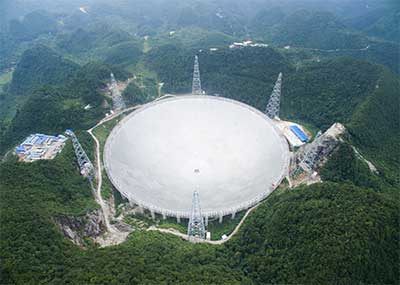Daily-current-affairs
/
05 Nov 2020
World's Largest Telescope : Daily Current Affairs

World's Largest Telescope
IN NEWS
- China announced Wednesday that its Five-hundred-meter Aperture Spherical Telescope
(FAST) - the world's largest and most powerful
radio telescope - has discovered more than 240
pulsars and is expected to detect the primordial
gravitational wave of the Big Bang.
ABOUT
- The Five-hundred-meter Aperture Spherical radio is a radio telescope located in the Dawodang
depression a natural basin in Pingtang County, Guizhou, southwest China.
- It is the world's largest filled-aperture radio telescope, and the second-largest single-dish
aperture after the sparsely-filled RATAN-600 in Russia.
- Construction on the FAST project began in 2011 and it achieved first light in September
2016.After a three-year testing and commissioning period it was declared fully operational on
11 January 2020.
- FAST has discovered more than 240 pulsars, and more than 40 high-level papers have been
published based on the telescope's data.
- The sensitivity of FAST is more than 2.5 times that of the world's second largest single-aperture
radio telescope. This is the first time that a China-built radio telescope has topped the world on
the important indicator of sensitivity.
INDIA’S LARGEST GAMMA-RAY TELESCOPE
- India’s largest and the world’s highest gamma-ray telescope is live this year, aiming to provide a
new window into distant stars and galaxies in the universe.The Major Atmospheric Cherenkov
Experiment Telescope (MACE) in Hanle, Ladakh, is placed at an altitude of 4,300 metres above
sea level.
- It is the world’s second-largest, ground-based gamma-ray telescope with a 21-metre-diameter
dish. The largest telescope of the same class is the 28-metre-diameter telescope, which is part
of the High Energy Stereoscopic System (HESS) in Namibia.
SOME IMPORTANT FACTS
- Govind Swarup, one of the pioneers of Radio astronomy, and known as the ‘Father of Indian
Radio Astronomy’ passed away on 7 September 2020 after a period of short illness at the age of
91.
- The Indian Institute of Astrophysics (IIA), with its headquarters in Bengaluru (Karnataka state), is
an autonomous Research Institute wholly financed by the department of Science and
Technology, Government of India. IIA conducts research primarily in the areas of astronomy,
astrophysics and related fields.
- The GROWTH-India telescope is a 0.7 meter wide-field optical telescope that had first light in
2018. It is the country's first fully robotic research telescope. It was set up as a part of the
international GROWTH program, and has been widely used for time domain astronomy.
- The origin of Indian studies in astronomy can be traced to a private observatory established by
William Petrie (died: 1816), an officer of the East India Company. He set up that private
observatory in his residence located in Egmore, Chennai (formerly Madras), India.







